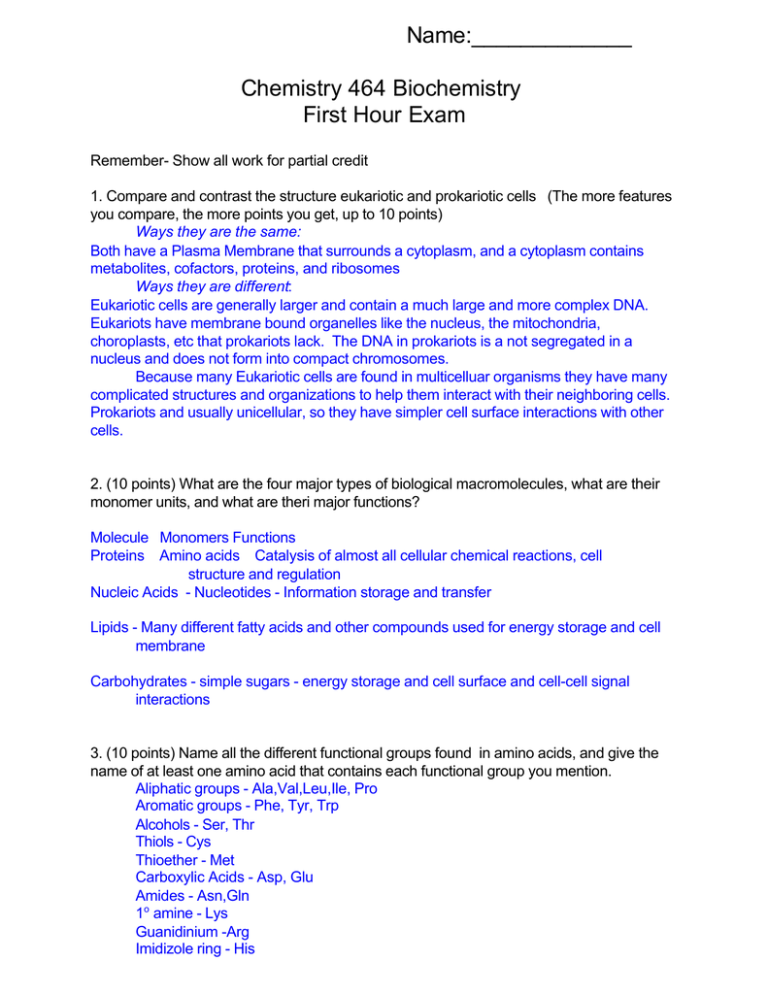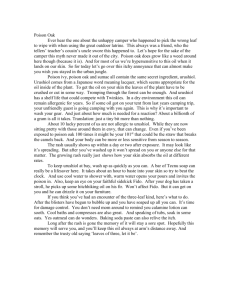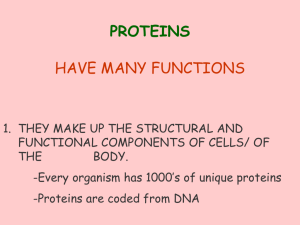Name:_____________ Chemistry 464 Biochemistry First Hour Exam
advertisement

Name:_____________ Chemistry 464 Biochemistry First Hour Exam Remember- Show all work for partial credit 1. Compare and contrast the structure eukariotic and prokariotic cells (The more features you compare, the more points you get, up to 10 points) Ways they are the same: Both have a Plasma Membrane that surrounds a cytoplasm, and a cytoplasm contains metabolites, cofactors, proteins, and ribosomes Ways they are different: Eukariotic cells are generally larger and contain a much large and more complex DNA. Eukariots have membrane bound organelles like the nucleus, the mitochondria, choroplasts, etc that prokariots lack. The DNA in prokariots is a not segregated in a nucleus and does not form into compact chromosomes. Because many Eukariotic cells are found in multicelluar organisms they have many complicated structures and organizations to help them interact with their neighboring cells. Prokariots and usually unicellular, so they have simpler cell surface interactions with other cells. 2. (10 points) What are the four major types of biological macromolecules, what are their monomer units, and what are theri major functions? Molecule Monomers Functions Proteins Amino acids Catalysis of almost all cellular chemical reactions, cell structure and regulation Nucleic Acids - Nucleotides - Information storage and transfer Lipids - Many different fatty acids and other compounds used for energy storage and cell membrane Carbohydrates - simple sugars - energy storage and cell surface and cell-cell signal interactions 3. (10 points) Name all the different functional groups found in amino acids, and give the name of at least one amino acid that contains each functional group you mention. Aliphatic groups - Ala,Val,Leu,Ile, Pro Aromatic groups - Phe, Tyr, Trp Alcohols - Ser, Thr Thiols - Cys Thioether - Met Carboxylic Acids - Asp, Glu Amides - Asn,Gln 1o amine - Lys Guanidinium -Arg Imidizole ring - His 2 4. (10 points) I have a 0.1 molar phosphate buffer that is at pH 7.0. What is the pH of this buffer after I add 15 mls of 0.1M HCl to 100 mls of the buffer. (The pKa of phosphate is 6.86) Step 1 Establish current concentrations of HA and A HA + A - = .1; HA = .1-A pH = pKa + log (A -/HA); 7=6.86 + log (A -/HA); .14=log (A -/(.1-A -)) 10.14 = 1.38 = A -/(.1-A -); .138 -1.38A- = A .138 = 2.38A-; A- = .138/2.38 = .058M; HA = .042M Step 2 See what happens when you add the acid add 15 mls of .1M HCl .015L x .1 mol/liter = .0015 moles You had 100 ml of .058 M A - = .0058 mole and 100 ml of .042M HA = .0042 moles H+ + A -6HA so A - = .0058-.0015, HA = .0042 + .0015; A- = .0043, HA = .0057 pH = 6.86 + log (.0043/.0057) pH = 6.74 5. (10 points) Urushiol it the main constituent of the irritant oil of poison ivy. The structure of urushiol is: OH OH R R= (CH2 )14CH3 (CH2) 7CH=CH(CH2 )5CH3 And other similar long chain hydrocarbons On the next page are portions of the web page for a product called Ivy Off that claims to clean the Urushiol off your skin. While I haven’t tried it, I have heard quite a few Boy Scouts say it actually works. A. Based on the physical properties you might expect for Urusiol explain, why simply washing with soap and water would not be effective. Urushiol is primarily a long hydrophobic tail with only a slightly polar aromatic head group. This will not be easily solubilized by the soap, and, in fact, is probably already incorporating itself into the membranes of skin cells B. What might Ivy Off contain to make it effective. To make Ivy-Off effective, it must contain a base that will deprotonate the phenol groups, making them charged. This now makes the phenolic ring much more soluble, so that now soap has a chance to remove the urushiol from the skin, as well as making it less likely to want to bury itself in the cell membrane. C. (Extra Credit) Based on the above answer, can you think of a way to remove Urushiol using common household chemicals? A simple replacement might be a household base like ammonia or sodium Bicarbonate (Baking Soda). My guess is that you would want to apply a soapy baking soda solution and leave it on for a few minutes to help get the urushiol that has already incorporated into cell membranes a chance to dissolve in the solution. Ammonia would probably work too, but it would be smellier, and maybe more irritating. 3 6. (20 points) Fill in the following table: Name Tryptophan Glutamine Cystiene 3 letter abbreviation Trp Gln Cys 1 letter abbreviation W Q C Structure O NH 2 SH CH 2 NH NH 3+ CH 2 NH 3+ CH2 CH 2 COO- NH3+ COOH H COOH side chain pKa (if ionizable) NA NA 8.18 General classification (nonpolar, polar, etc) Aromatic, nonpolar Polar Polar 7. (10 points) I have the peptide with the sequence TEST. Write the structure of this peptide at pH 2 and 7 with all charged groups in their proper ionization state. Thr-Glu-Ser-Thr pH 2 COOH CH3 HC OH NH3 + H CO N H CH2 CH2 H CH3 H2 C OH CO N H H CO N H HC OH Actually the COO- is close to its pKa so it is only about ½ protonated at pH2 COOH H pH 7 - The two COOH groups are fully deprotonated and carry a - charge 4 8. (5 points) What is FDNB and how is it used in biochemistry? 1-fluoro-2,4-dinitrobenzene or Sanger reagent. Used to identify the N-terminal amino acid. 9. (5 points) What is Cyanogen Bromide and how is it used in Biochemistry CNBr, a chemical agent that cleaves the peptide chain on the C side of a methionine residue, used to cleave a protein into smaller peptides for sequencing 10. (5 points) What is an Edman degradation and how is it used in Biochemistry? A repetitive way of cleaving amino acids form the N terminal end of a protein or peptide using phenylisothiosyanate. Used in protein sequencers to determine the sequence of peptides up to about 50 residues in length. 11. (5 points) What is the Mass Spectrometer and how is it used in Biochemistry? An instrument that a changes a molecule into an ion, and then determines the molecules mass by monitoring how that ion moves in a vacuum. Used in Biochemistry both to determine the molar mass of a protein or DNA, and can also be used to sequence a protein.




